Carbon Footprint Report of Schneider Electric’s ‘Xperience Efficiency Yatra 2013’ Event
Schneider Electric Pvt. Ltd. commissioned cBalance to prepare a report showcasing the total carbon footprint of ‘Xperience Efficiency Yatra-2013,’ an event held across 44 cities that demonstrated how new energy technologies can change our lives and was attended by 11,792 customers and 3,422 Schneider Electric employees. The greenhouse gases (GHG) inventory was calculated using the sample data of 11 cities provided by Schneider Electric and generalizing for all 44 cities and accounted for the three major greenhouse gases: carbon dioxide (CO2), methane (CH4), and nitrous oxide (N2O). It was calculated according to the standards laid down in the GHG Protocol.
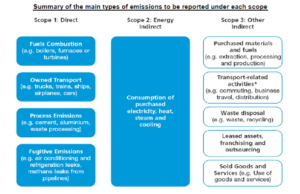
In the case of this report, the operational boundary for the GHG inventory was defined as:
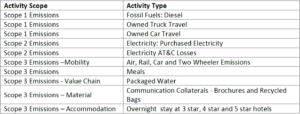
Research Methodology
The research methodology consisted of the following steps:
- Design questionnaire
- Data collection
- Data verification
- GHG inventory calculations
- Daya analysis
- Reporting
Data
Data was obtained through a questionnaire designed by cBalance and collected by the Schneider Electric Marcom team at two levels: central and venue.
- Central level data came from the back office of the Marcom team and included information such as hotel accommodations, communication materials, and air, rail, and bus travel of Schneider Electric employees, etc. It was available for all the 44 city events and the GHG emissions of these activities are, thus, calculated for all of them.
- Venue level data was collected at the venues with the hotel staff as respondents. A universally applicable sample of 11 cities’ data was analyzed at the venue level.
cBalance used Footprint Reporter (FPR) to calculate GHG emissions, with the Footprint Report Emission Factor Database (EFDB) used as background data.
Electricity consumption:
Electricity consumption was calculated by using the number of hours the floor space of the venue was used for the event, with predefined electricity usage per square meter for 3 star, 4 star, and 5 star facilities being used for the analysis. It’s assumed that each session is 4.5 hours long (3 for assembly and 1.5 for disantling) and that events take place for 15 days in a month with an average of 8 hours per event.
Air travel:
Air travel activity data was calculated by estimating average passenger-km per flight (modeling that single flight by short, medium, and long haul type in FPR) and multiplying the footprint of each flight type by the total quantity of landings/take-offs (including stopovers), including circling-inefficiency (for domestic travel), per flight type. Short haul distances are defined to be between 0 to 694.5 km, Medium Haul distances defined as 995 to 1,620.5 km, and Long Haul distances are defined as 1,621 to 2,778 kms.
City travel and intercity travel of attendees:
The intercity travel of the attendees was considered to be 10% of the total attendees, with the other 90% traveling within the city. It was calculated for all modes of transport using the same data of city and intercity travel and was then estimated for the grand total attendees for all the events.
Accommodation:
Total overnight stay of employees of Schneider Electric in 3 star, 4 star, and 5 star facilities in different climatic zones (i.e. warm and humid, hot and dry, temperate) was computed and then modeled in FPR.
Food and Beverage:
It was assumed that every attendee consumed a liter of water at the event, and the emission per meal served was considered to be 0.855 kgCO2e.
Other activity data:
This included fuel consumption for diesel generator, heavy motor vehicles used in the logistics of the event, train and bus travel of Schneider Electric employees, and the total weight of recycled bags and brochures used.
Results
Scope 1, 2, 3 GHG Emissions:
As shown by the table and chart below, Scope 3 emissions were the largest contributor, at 57.8%, and Scope 1 emissions were the second largest, at 28.8%.

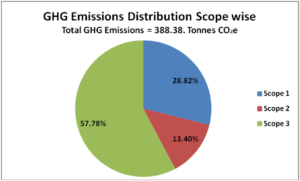
Scope 1 GHG emissions:
Heavy motorized vehicles used for event logistics were far and away the largest source of Scope 1 emissions, as is evident from the table and chart below.

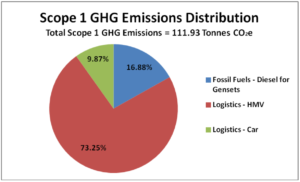
Scope 2 emissions:
As demonstrated by the following table, all Scope 2 emissions are the consequence of electricity use. In terms of total magnitude, these emissions have a relatively low impact on the total GHG emissions as the events are not energy intensive and do not rely upon electrically powered machines or processes. These emissions consist of both- electricity purchased and AT&C losses.

Scope 3 emissions:
The table and chart below make it clear that accommodation was the largest source of Scope 3 emissions, followed by intercity travel.
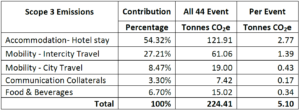
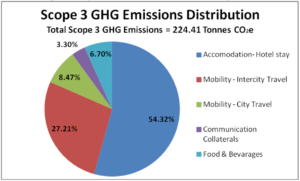
Activity category-wise emissions:
Breaking down the emissions by activity gives us a different perspective from which to view the event’s carbon footprint. Accommodation was the single largest contributor to activity category-wise emissions, with 31.4 % of total GHG emissions, followed by logistics (24.0%). Intercity travel and purchased electricity consumption were also significant, at 15.7% and 13.4%, respectively. The rest were rather minor contributors.
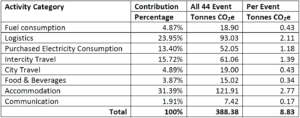
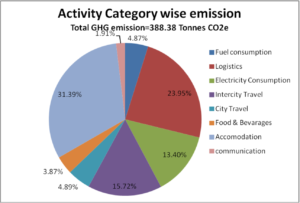
Conclusion
This illustrates the total Carbon Footprint Summary of all the 44 city events as well as an average representing that for each city event. Total GHG emissions for all 44 city events amount to 388.384 Tonnes of CO2e, while GHG emissions per city event are 8.827 Tonnes of CO2e.
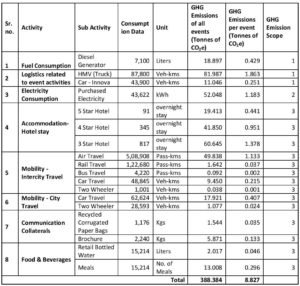
The original study can be read here.
Comments are closed